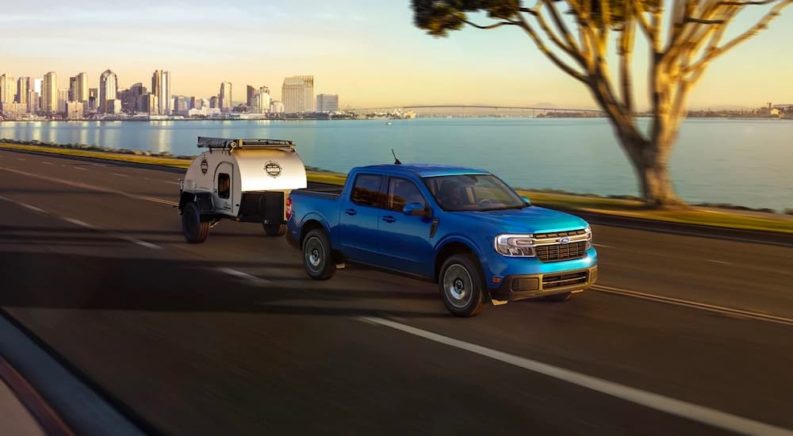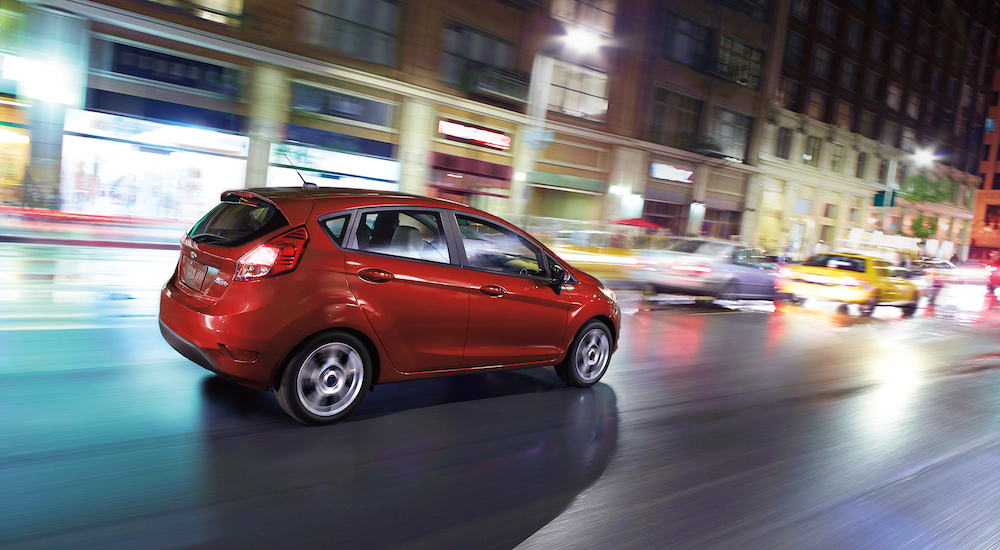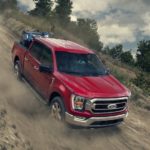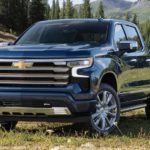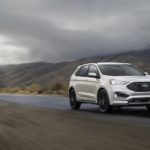As automakers work to keep abreast of changing consumer tastes and market conditions, models are always coming in and out of the lineup. While certain offerings, like the all-time best-selling Ford F-150, are untouchable, few other models are immune. When it comes to searching the inventory at a Ford dealership near you, the biggest change in recent years was probably the brand’s decision to drop all but one car from its lineup. This might seem like an odd decision coming from, you know, a car company, but with the massive rise in popularity of the crossover SUV segment and a strong presence in the truck market, the Big Blue Oval has decided to focus on what it does best and phase out more traditional sedans.
One car survived the purge––the iconic Ford Mustang––and while there were plans to offer a crossover-inspired version of the Ford Focus sedan, Ford scrapped the model due to tariff issues. The move marks a drastic change for the legacy automaker, which prior to 2018, sold six different sedans and coupes, including the Fiesta, Focus, Fusion, C-Max, Mustang, and Taurus. While many of these models are still available on the international market, it begs the question: how many Ford models are out there? Let’s take a closer look at the current lineup of Ford vehicles available in America, as well as some intriguing new models and old favorites that can be found in overseas markets.
American Models
Cars
Mustang – It’s little surprise that the original pony car survived Ford’s recent house cleaning. The powerful sports car has captured hearts and minds since its debut in 1964, becoming synonymous with the very concept of American muscle. Ford has had a lot of fun with the Mustang over the years, introducing a number of variants that include the GT, Mach 1, Shelby, and more. There’s also a new EV variant of the popular muscle car, though it’s technically classified as an SUV.
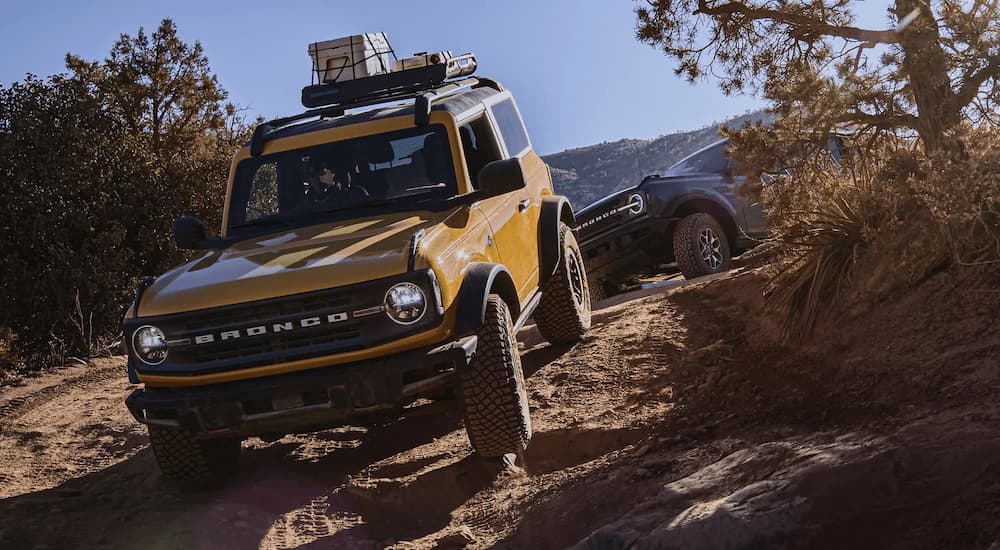
SUVs
- EcoSport – The EcoSport is one of the rare models that originated in the international market and has only recently hit American shores. Built in Brazil since 2003, the second generation of the subcompact crossover came to the American market in 2018. Sadly it wasn’t to last long as Ford announced the discontinuation of the crossover following the 2022 model year.
- Escape/Escape PHEV – The Escape is soon to be Ford’s smallest crossover with the departure of the EcoSport. Originally designed in cooperation with Mazda 2001, the compact SUV is currently in its fourth generation. Offered in both FWD and AWD, the crossover has proved popular since its debut, and two new versions––a hybrid and plug-in hybrid––have gone a long way in driving consumer interest in recent years.
- Edge – The Edge is Ford’s midsize crossover contender and was originally born as a trim for the Ford Ranger pickup. Slotting in between the Escape and Explorer in Ford’s crossover SUV lineup, the Edge shares more than a couple attributes with the Fusion sedan. The second-generation Edge, which hit the market in 2015, has a peppy 2.0-liter EcoBoost engine as well as an eight-speed automatic transmission and a new twin-scroll turbo that improves low-end torque.
- Explorer – The three-row midsize crossover is a versatile SUV that combines the size of a traditional SUV with the ride comfort, responsiveness, and efficiency of a crossover. A mainstay in the Ford lineup since 1991, the SUV has done an admirable job of changing with the times, introducing new crossover construction as well as hybrid and PHEV options in recent years. If the Explorer’s silhouette looks familiar, it’s because the SUV is a popular option for law enforcement use, where it’s dubbed the Police Interceptor Utility.
- Expedition/Expedition Max – The full-size Expedition was first introduced in 1997 as the successor to the popular Ford Bronco. The SUV retains the Bronco’s heavy-duty body-on-frame construction, which goes a long way in expanding the model’s functionality in off-road environments. That said, the Expedition’s real claim to fame is its cargo and passenger room, with three rows of seating capable of accommodating even the largest family or DIY project. Still not big enough for you? Ford also offers a longer Expedition Max variant with a long wheelbase.
- Bronco – Easily the most rugged SUV in Ford’s current lineup, the Bronco was reintroduced in 2021 after a 25-year hiatus, though it retains the iconic boxy look of the original. Built with a body-on-frame method similar to many of today’s pickup trucks, the midsize Bronco is an off-road beast equipped with standard four-wheel drive and two 4×4 systems to choose from. The SUV is available in 2-door and 4-door styles, both of which have removable doors and roofs.
- Bronco Sport – The Bronco Sport is a compact crossover SUV that essentially serves as a scaled-down version of the Bronco and shares its unibody platform with the Escape SUV and Maverick pickup. The Bronco Sport lacks the Bronco’s body-on-frame construction and 4WD and isn’t quite as well-equipped for off-road scenarios, but the SUV does retain the sporty, throwback styling of its big brother.
- Mustang Mach-E – Ford is blazing the way when it comes to introducing new EV powertrains for some of its most popular vehicles, with the Mustang Mach-E and F-150 Lightning serving as prime examples. The EV version of Ford’s popular Mustang might technically be an SUV, but it shares a name and styling with the brand’s popular pony car. Most importantly, it’s fun to drive, doing the Mustang name proud with a powerful 88 kW battery that can produce some 480 hp.
Trucks
- Maverick – Recently introduced in 2021, the Maverick is a compact pickup that shares a platform with the Edge and Bronco Sport SUVs. The front-wheel drive pickup might not be the most powerful truck in Ford’s lineup, but it’s an appealing option for drivers seeking to meld a truck’s cargo room and ride height with the efficiency and comfort of a smaller vehicle. The pickup is also offered with a hybrid powertrain, further increasing the Maverick’s value.
- Ranger – Ford’s midsize pickup has been around since 1983, providing drivers with a step down from the full-size F-150 that still retains much of the larger truck’s robust functionality. The Ranger was a compact pickup until 2012, when it was discontinued, only to be reborn in 2019 as a midsize truck. While the pickup was first built in collaboration with Mazda, it’s been an in-house effort since 2011, when Ford introduced the new T6 platform.
- F-150 – What can we say about the F-150 that hasn’t already been said? The half-ton truck isn’t just America’s best-selling pickup since 1977; it’s the best-selling vehicle of any kind with a reputation for performance that’s kept it at the top of the heap all these years. The light-duty F-150 can tow up to 14,000 lbs while still offering a comfortable and relatively efficient ride, making the pickup a popular choice for those who expect their vehicles to fulfill multiple roles.
- F-150 Lightning – Once again, Ford is here to smash any expectations about what an EV can be. The brand made waves in the industry with the instruction of the F-150 Lightning, which combines the best-selling truck’s reputation for performance and reliability with a next-generation EV powertrain. Since hitting the market in 2022, the electric truck has impressed drivers across the board, who cite the unique torque advantages of the EV setup as one of the best things to happen to the pickup market in recent memory.
- Super Duty – For those who value power and performance above all else, there’s the Ford Super Duty lineup. Aimed more at the commercial and industrial sector than the individual consumer market, these beefy pickups are ideal for any drivers who see a lot of towing and hauling in the future. The fourth-generation Super Duty trucks are built using a different chassis, frame, and components than the base F-150, giving the Super Duty trucks the reinforced construction they need to meet the needs of any job.
International Models
Ford has long had a strong presence on the international market and operates manufacturing facilities on nearly every continent. These global sales accounted for nearly half of the automaker’s output in 2021, with almost 2 million units sold. The Detroit-based automaker has a particularly strong presence in Europe and China, where a rapidly growing auto market has led to robust expansion in recent years. International models run the gamut from retooled versions of familiar North American models to entirely new creations designed to fit the particular needs, infrastructure, and policy requirements of a specific country or region. We’re only going to cover models not currently sold in America, although we will make a note of certain vehicles that are available under a different name.
Cars
- Fiesta – The Fiesta might have gotten the ax in the North American market, but the subcompact hatchback is still going strong in Europe. First introduced in 1977, the Fiesta has been a popular economy option for decades.
- Focus – The compact hatchback Focus is still sold in Europe, and a sedan version of the vehicle can be found in China and Eastern European markets. Debuting in 1998 and winning the European Car of the Year award in 1999, the popular compact has taken many forms over the years as a hatchback, sedan, coupe, and even a coupé-cabriolet.
- Escort – Ford revived the compact Escort for the Chinese market in 2015. The original Escort debuted in 1968 and was a staple of the European market until it was replaced by the Focus, but this new version is actually based on an older generation of the popular Focus.
- Mondeo/Taurus – The Mondeo is a midsize family sedan that was previously sold in America as the Ford Fusion. The sedan is sold in China and Europe as the Mondeo, though European production will cease following the 2022 model year. In the Middle East, this vehicle is marketed as the Ford Taurus, though it’s not the same vehicle as the Taurus currently being sold in China.
- Taurus – Ford’s full-size sedan was a popular choice in America since it was first sold in 1986 but was one of the many Ford cars cut from the lineup after 2018. A new version of the sedan has been sold in China and the Middle East since 2015 as part of the Changan Ford joint venture.
SUVs
- Puma – The subcompact Puma takes design inspiration from the Ford Fiesta and shares many features with the hatchback’s seventh-generation model. Available in the European and Asian markets, the SUV first debuted in 2019 and slots in just below the Kuga in Ford’s international lineup.
- Territory – Sold in China, South America, and Southeast Asia as the Territory, this compact crossover SUV was produced as part of the JMC-Ford joint venture. First sold in China in 2018, the Territory is actually a rebadged and modestly redesigned version of JMC’s Yusheng S330. The entry-level compact fits in well between the EcoSport and Escape, giving drivers a well-balanced mix of size, style, and comfort.
- Kuga – The compact Kuga is simply the European name for the Ford Escape. While the vehicles were two different models up until 2012, they’ve since been merged into one offering with both hybrid and PHEV versions available.
- Endura – The Endura is a rebadged version of the Edge midsize crossover SUV for the Australian market, though it retains the Edge moniker in Europe, China, and other international markets. The two-row SUV is also available in a three-row version in the Chinese market, where it is known as the Edge Plus.
- Equator – A joint venture between Ford and Chinese auto manufacturer Jiangling Motors Corporation Limited (JMC), the Equator is a midsize, three-row crossover SUV first introduced in 2021. A slightly smaller version of the Equator, previously known as the Equator Sport, is now being sold outside of China as the Ford Territory (which is a distinct model from the Territory sold within China).
- Evos – Another crossover SUV designed as part of the Ford Changan joint venture, the Evos is notable for its sporty, low-slung design. The SUV also features a host of impressive tech features, including a massive 3.6-foot touchscreen display that wraps across almost the entire dashboard.
- Everest/Endeavor – The smallest of Ford’s traditional body-on-frame SUVs sold on the international market––specifically the Asia-Pacific region––the Everest is based on the Ford Ranger midsize pickup. In India, the model is known as the Endeavour due to a naming conflict with a popular spice brand.
Trucks
When it comes to trucks, the American names apparently hold some sort of cultural cache because all international models are sold under the same names as their American counterparts. Given our country’s reputation as the birthplace of the pickup truck, this comes as little surprise, as does Ford’s dominance of the international pickup market. Ford was the first automaker to produce a pickup back in 1917 with the debut of the Ford Model TT, and it looks like the rest of the industry is still playing catch-up.
Ford Is a Global Brand
With such an extensive lineup to choose from, there’s a Ford vehicle out there to fit the needs of almost every driver. The brand has made some major inroads in the Asian market, specifically China, where two joint ventures have allowed the legacy automaker to quickly gobble up market share. It’s interesting to keep track of the automaker’s moves both home and abroad as they work to meet the ever-changing needs of its global consumer base, introducing entirely new concepts like the all-electric F-150 Lightning pickup in a bid to stay ahead of the competition. The rise of the crossover SUV is well reflected in Ford’s recent decision to discontinue most of its sedans on the American market, though we’re curious to see how long this trend will continue. No matter what the future holds, we expect Ford to be right at the forefront of automotive innovations, just like it has been for the past 100-plus years.

